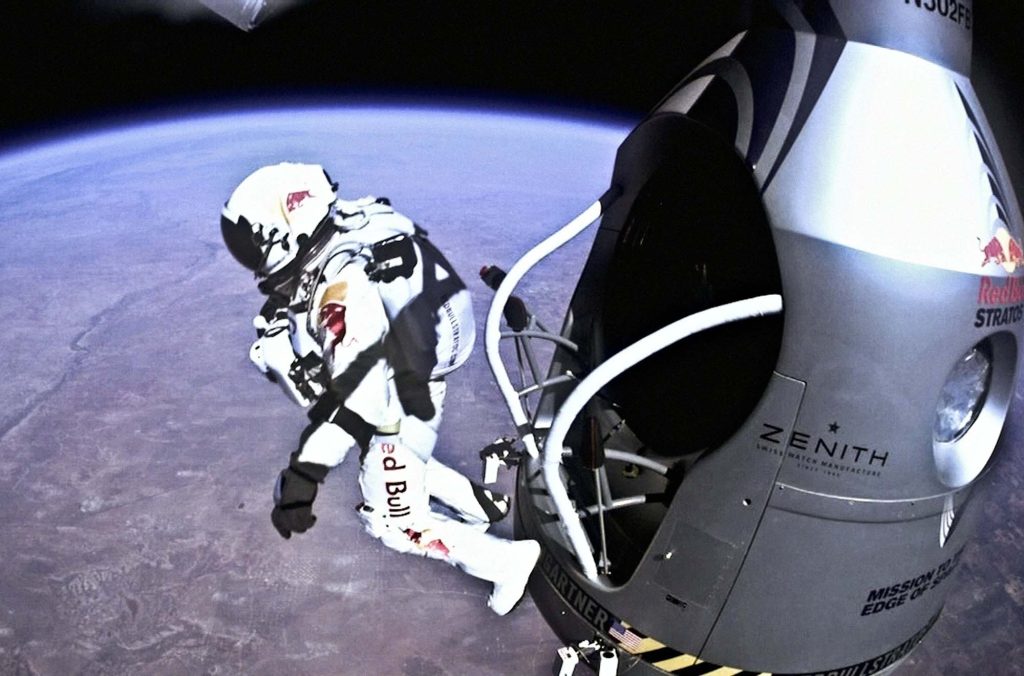Felix Baumgartner is a name that will forever be associated with one of the most awe-inspiring feats of human endurance and bravery. On October 14, 2012, the world held its breath as the Austrian skydiver and daredevil leaped from the stratosphere, plunging from a staggering altitude of nearly 40 kilometers (24 miles) above the New Mexico desert. Baumgartner’s jump from a specially designed capsule, suspended beneath a massive helium balloon, marked a new frontier in human exploration, setting multiple world records and captivating millions around the globe.
Baumgartner’s jump was not a mere stunt; it was a meticulously planned mission that took years of preparation, testing, and coordination. The project, sponsored by Red Bull and officially named the Red Bull Stratos, had one goal in mind: to break the sound barrier with the human body in free fall. Baumgartner would achieve this by jumping from the edge of space, descending at supersonic speeds, and landing safely on Earth. The mission was as much about advancing scientific knowledge and pushing the boundaries of human capability as it was about spectacle.
The jump itself was a nail-biting event. As Baumgartner ascended into the stratosphere, the capsule reached an altitude of 39,045 meters (128,100 feet), where the Earth’s atmosphere is so thin that temperatures plummet, and there is barely any oxygen. Wearing a specially designed pressurized suit and helmet, Baumgartner stepped onto a tiny platform outside the capsule and prepared to leap into the unknown. After a few moments of reflection and final checks, he uttered the words, “I’m going home now,” and pushed off into the vastness of the sky.
What followed was a freefall unlike any other. For the first 34 seconds of his descent, Baumgartner accelerated uncontrollably, breaking the sound barrier and reaching a top speed of 1,357.64 km/h (843.6 mph). He became the first human to break the sound barrier in free fall, a feat previously thought impossible. The intense forces acting on his body caused him to spin uncontrollably at times, but thanks to his training and suit design, he regained control before his descent became too dangerous.

During the four-minute and 20-second freefall, Baumgartner experienced some of the most extreme conditions known to man. The thin air provided little resistance, allowing him to fall faster and faster before his parachute deployed at an altitude of about 5,000 feet (1,524 meters), ensuring a safe landing on the ground. When he touched down, millions who watched live breathed a collective sigh of relief, celebrating not just Baumgartner’s courage but the technological achievements that made such a jump possible.
The mission was not just a showcase of human bravery and technical prowess; it also contributed valuable data to science and the aerospace industry. NASA and other space agencies closely observed the jump to gather insights that could help improve the safety of high-altitude space flights and enhance emergency escape systems for astronauts. Baumgartner’s suit and the technology behind it provided useful data for future space missions, particularly in terms of how the human body reacts to extreme conditions during high-speed re-entry into Earth’s atmosphere.
Baumgartner’s record-setting jump also had a lasting impact on popular culture. It reminded the world of humanity’s innate desire to explore, to push the limits of what is possible, and to test the boundaries of human endurance. It was a modern-day version of the pioneering spirit that led to historic achievements such as the moon landing and the first flight by the Wright brothers. Felix Baumgartner’s leap became a symbol of courage and ambition, proving that even in the 21st century, there are still frontiers left to conquer.
However, the mission was not without its risks. The extreme altitude and speed could have easily resulted in disaster. Had Baumgartner’s suit or parachute failed, the consequences could have been fatal. Yet, these dangers were meticulously accounted for in the planning stages. The Red Bull Stratos team included some of the brightest minds in aerospace, including Joe Kittinger, the previous record holder for the highest parachute jump and a retired U.S. Air Force colonel. Kittinger provided guidance and support throughout the mission, passing the torch to Baumgartner as he prepared to break his 1960 record.
Since his historic leap, Baumgartner has remained an inspirational figure, though he has largely stepped away from the spotlight. His achievement continues to inspire new generations of adventurers, scientists, and space enthusiasts, demonstrating that even in an era of rapid technological advancement, the human spirit’s drive to explore remains as strong as ever.
In the years since the jump, Red Bull Stratos has been celebrated as one of the most significant achievements in extreme sports and aerospace. It serves as a reminder that while the vastness of space may seem insurmountable, human ingenuity and determination can bring us closer to the stars. Felix Baumgartner’s leap from the edge of space will forever be remembered as one of the most daring and inspiring moments in modern history. His courage and the teamwork behind the mission have left an indelible mark on the world, proving that when humanity dares to dream, even the sky is no limit.

